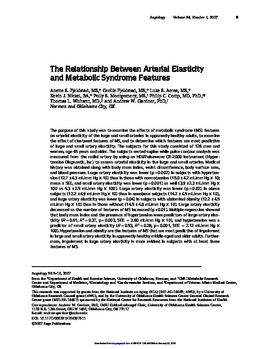| dc.contributor.author | Anette S. Fjeldstad | |
| dc.contributor.author | Cecilie Fjeldstad | |
| dc.contributor.author | Luke S. Acree | |
| dc.contributor.author | Kevin J. Nickel | |
| dc.contributor.author | Polly S. Montgomery | |
| dc.contributor.author | Philip C. Comp | |
| dc.contributor.author | Thomas L. Whitsett | |
| dc.contributor.author | Andrew W. Gardner | |
| dc.date.accessioned | 2016-01-14T19:53:22Z | |
| dc.date.accessioned | 2016-03-30T15:33:40Z | |
| dc.date.available | 2016-01-14T19:53:22Z | |
| dc.date.available | 2016-03-30T15:33:40Z | |
| dc.date.issued | 2007-02-01 | |
| dc.identifier.citation | Fjeldstad, A. S., Fjeldstad, C., Acree, L. S., Nickel, K. J., Montgomery, P. S., Comp, P. C., . . . Gardner, A. W. (2007). The Relationship Between Arterial Elasticity and Metabolic Syndrome Features. Angiology, 58(1), 5-10. doi: 10.1177/0003319706297911 | en_US |
| dc.identifier.uri | https://hdl.handle.net/11244/25216 | |
| dc.description.abstract | The purpose of this study was to examine the effects of metabolic syndrome (MS) features on arterial elasticity of the large and small arteries in apparently healthy adults, to examine the effect of clustered features of MS, and to determine which features are most predictive of large and small artery elasticity. The subjects for this study consisted of 126 men and women, age 45 years and older. The subjects rested supine while pulse contour analysis was measured from the radial artery by using an HDI/Pulsewave CR-2000 instrument (Hypertension Diagnostic, Inc) to assess arterial elasticity in the large and small arteries. Medical history was obtained along with body mass index, waist circumference, body surface area, and blood pressure. Large artery elasticity was lower (p=0.002) in subjects with hypertension (12.7 ∓4.3 mL/mm Hg × 10) than in those with normotension (15.0 ∓4.2 mL/mm Hg × 10; mean ∓ SD), and small artery elasticity was lower (p=0.001) as well (3.9 ∓2.3 mL/mm Hg × 100 vs 5.3 ∓2.5 mL/mm Hg × 100). Large artery elasticity was lower (p=0.02) in obese subjects (12.2 ∓4.9 mL/mm Hg × 10) than in nonobese subjects (14.2 ∓4.5 mL/mm Hg × 10), and large artery elasticity was lower (p=0.04) in subjects with abdominal obesity (12.2 ∓4.5 mL/mm Hg × 10) than in those without (14.5 ∓4.8 mL/mm Hg × 10). Large artery elasticity decreased as the number of features of MS increased (p<0.01). Multiple regression showed that body mass index and the presence of hypertension were predictors of large artery elasticity (R =0.61, R 2 =0.37, p=0.003, SEE = 3.60 mL/mm Hg × 10), and hypertension was a predictor of small artery elasticity (R =0.53, R 2 =0.28, p=0.001, SEE = 2.12 mL/mm Hg × 100). Hypertension and obesity are the features of MS that are most predictive of impairment in large and small artery elasticity in apparently healthy middle-aged and older adults. Furthermore, impairment in large artery elasticity is more evident in subjects with at least three features of MS. | en_US |
| dc.language.iso | en_US | en_US |
| dc.publisher | Angiology | |
| dc.title | The Relationship Between Arterial Elasticity and Metabolic Syndrome Features | en_US |
| dc.type | Research Article | en_US |
| dc.description.peerreview | Yes | en_US |
| dc.description.peerreviewnotes | https://us.sagepub.com/en-us/nam/manuscript-submission-guidelines | en_US |
| dc.identifier.doi | 10.1177/0003319706297911 | en_US |
| dc.rights.requestable | false | en_US |
